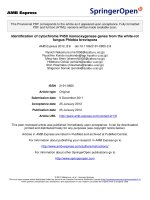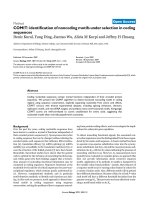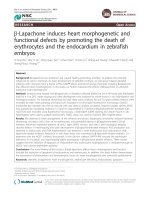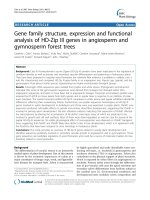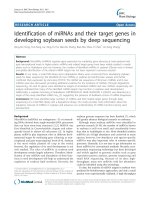IDENTIFICATION OF IRF6 DOWNSTREAM TARGET GENES IN ZEBRAFISH
Bạn đang xem bản rút gọn của tài liệu. Xem và tải ngay bản đầy đủ của tài liệu tại đây (6.06 MB, 85 trang )
Identification of IRF6 Downstream Target Genes in Zebrafish.
MA YANKUN
(Bachelor of Science, Zhejiang University)
A THESIS SUBMITTED
FOR THE DEGREE OF MASTER OF SCIENCE
DEPARTMENG OF PAEDIATRICS
NATIONAL UNVIERSITY OF SINGAPORE
2013
Declaration
I hereby declare that this thesis is my original work and it has been written by me in its
entirety.
I have duly acknowledged all the sources of information which have been used in the
thesis.
This thesis has also not been submitted for any degree in any university previously.
V
Ma Yankun
August 1, 2013
1
Acknowledgement
Foremost, I would like to express my sincere gratitude to my supervisor, Prof. Samuel
Chong, for his continuous support of my MSc research and personal development, for his
advice, patience, enthusiasm, and immense knowledge. His guidance helped me through
this wonderful journey of research and learning. I am very grateful for the opportunity to
work with him and it has been my privilege to learn from him. I could not have imagined
having a better advisor and mentor for my MSc study.
Besides my supervisor, I would like to thank the rest of my thesis advisory committee: Prof.
Heng Chew-Kiat and Prof. Lee Guat Lay Caroline for their encouragement, insightful
comments, and precious advice.
Sincere gratitude also goes to Dr Felicia Cheah, for her effort in initiating the project, and
the valuable suggestions regarding both my MSc study and living in Singapore. I would
also like to express my utmost appreciation to all members working under Prof. Sam’s
group, for their friendship, support and effort in making the whole group feel like a big
family: Mr. Arnold Tan, Ms. Chen Min, Ms. Indhu Shree, Mr. Eugene Saw, Ms. Zhao
Mingjue, Ms. Phang Guiping, Ms Mulias and many others.
Financial support from the National University of Singapore is sincerely acknowledged.
2
I am deeply thankful to my family for their love, support, and sacrifice. Without their
support, this thesis would never have been written.
3
Summary
Gastrulation is an important step in early embryogenesis. It involves a series of coordinated
cell movements to organize the germ layers and establish the major body axes of the
embryo (Lepage and Bruce, 2010; Wang and Steinbeisser, 2009). During the process of
studying interferon regulatory factor 6 (IRF6) which is known to be involved in syndromic
oral clefting, we found out a drastic and prominent knockdown phenotype leading by
Mopholino targeting at the splice junction of exon 3 and intron 3 of irf6 pre-mRNA (E3I3)
in zebrafish that strongly suggests a critical role of Irf6 in proper gastrulation and early
embryogenesis. In this study, we profiled the transcriptome of embryos lack of functional
Irf6 leading by the injection of E3I3 using the Agilent zebrafish gene expression microarray.
We identified and characterized cyr61 and mapkapk3 as target genes of Irf6 at gastrulation
stage in zebrafish. The findings gathered from this study will provide novel insights into
how IRF6 normally function in vertebrate embryogenesis and also contribute new
knowledge into understanding gastrulation process.
4
Table of Contents
Contents
Declaration .............................................................................................................................. 1
Acknowledgement .................................................................................................................. 2
Summary ................................................................................................................................. 4
Table of Contents .................................................................................................................... 5
List of Tables .......................................................................................................................... 8
List of Figures ......................................................................................................................... 9
Abbreviations ........................................................................................................................ 10
Chapter I: Introduction.......................................................................................................... 11
1.1 Early development of the zebrafish............................................................................. 11
1.1.1 Zebrafish as a model organism for the study of vertebrate development............. 11
1.1.2 Epiboly of zebrafish ............................................................................................. 13
1.1.3 Gastrulation of zebrafish ...................................................................................... 14
1.2 Role of IRF6 in development ...................................................................................... 16
1.2.1 Interferon Regulatory Factor ................................................................................ 16
1.2.2 IRF6 is important in early development in zebrafish and Xenopus ..................... 19
1.2.3 IRF6 and oral clefting ........................................................................................... 23
1.2.4 IRF6 in mouse development ................................................................................. 25
5
1.3 Other functions and regulation of IRF6 ...................................................................... 26
1.3.1 IRF6 functions as a transcriptional factor ............................................................ 26
1.3.2 IRF6 and cell proliferation and differentiation ..................................................... 26
1.3.3 Regulation of IRF6 ............................................................................................... 28
1.4 Microarray ................................................................................................................... 29
1.5 Objectives of the project ............................................................................................. 30
Chapter II: Materials and Methods ....................................................................................... 31
2.1: Ethics statement/ fish strain ...................................................................................... 31
2.2: Morpholino injection ................................................................................................. 31
2.3: Total RNA extraction from fish embryos ................................................................. 32
2.4: Microarray sample preparation and hybridization ..................................................... 33
2.5: Microarray analysis and statistics .............................................................................. 33
2.6: Semi-quantitative reverse-transcription PCR: .......................................................... 34
2.7: pcDNA/His-Irf6-FL and pcDNA/His-Irf6-E3I3 plasmid construction ..................... 35
2.7.1 Amplification of full length and truncated Irf6 .................................................... 35
2.7.2 Plasmid digestion.................................................................................................. 36
2.7.3 Creating blunt end ................................................................................................ 36
2.7.4 Ligation................................................................................................................. 36
2.7.5 Transformation ..................................................................................................... 37
2.8: In vitro protein expression ......................................................................................... 37
6
2.8.1: Generation of DNA templates for full length and truncated Irf6 protein
expression ...................................................................................................................... 37
2.8.2: Protein expression using TNT wheat germ expression system ........................... 38
2.9: Protein purification .................................................................................................... 38
2.10: Western blotting ....................................................................................................... 39
2.11: Electrophoretic mobility shift assay (EMSA) .......................................................... 41
Chapter III: Results ............................................................................................................... 43
3.1: Genome-wide gene profiling microarray analysis of the E3I3 injected embryos...... 43
3.2: Gene ontology study of differentiated expressed genes in E3I3 MO-injected embryos
........................................................................................................................................... 51
3.3: Microarray differential gene expression validation ................................................... 53
3.4: cyr61 and mapkapk3 are direct downstream targets of Irf6 ....................................... 55
3.5: Preliminary morphology study of cyr61 and mapkapk3 MO blocked embryos ........ 57
Chapter IV: Discussion ......................................................................................................... 62
4.1: Interpretation of expression profile of E3I3 MO-injected embryos: Irf6 functions as
an essential transcriptional factor during early development ............................................ 62
4.2 The multi-function role of IRF6 .................................................................................. 64
4.3 cyr61 and mapkapk3 are direct downstream targets of Irf6 ........................................ 65
4.4 Conclusion and future work ........................................................................................ 68
Reference .............................................................................................................................. 70
7
List of Tables
Table No:
Page
1. A summary of IRF family member functions
18
2. SDS-PAGE recipe
40
3. Antibody used in western blotting
41
4. Microarray gene expression analysis:
E3I3 MO-injected embryos vs mock-MO injected embryos.
8
45-49
List of Figures
Figure No.
Page
1
Structure of zebrafish embryo and progression of epiboly
14
2
The gastrulation period
15
3
Phylogenetic analysis of irf gene family and alignment of the predicted
19-20
proteins from different sprecies
4
Aberrant irf6 transcript variants can cause early embryonic lethality
23
5
Genes differentially regulated by Irf6 during early embryogenesis
50
6
Gene ontology analysis of differentially expressed genes
7
Validation of differentially expressed cyr61 and mapkapk3
54
8
cyr61 and mapkapk3 are directly bound by Irf6 and E3I3 truncated protein
56
9
mapkapk3 MO-injected embryos show defects in the epithelial layer
58
52-53
10 mapkapk3 MO does not cause a lethal phenotype for embryos
59
11 cyr61 MO-injected embryos show gastrulation defects.
60
12 One-quarter of cyr61 MO-injected embryos die after 24hours.
61
9
Abbreviations
CL/P
Cleft lip with or without the palate
CPO
Cleft palate only
C-terminal carboxyl-terminus
Cyr61
Cysteine-rich 61
DBD
DNA binding domain
E3I3
Mopholino targeting at the splice junction of exon 3 and intron 3 of irf6 pre-mRNA
EMSA
Electrophoretic mobility shift assay
EVL
Enveloping layer
GO
Gene ontology
IAD
IRF-associated domain
IFN
Interferon
IRF
Interferon regulatory factor
ISRE
Interferon-sensitive response element
Mapkapk3
mitogen-activated protein kinase-activated protein kinase 3
MH2
Mad-homology 2
MO
Mopholino
N-terminal Amino-terminus
PID
Protein interaction domain
PPS
Popliteal pterygium syndrome
SCC
Squamous cell carcinoma
VWS
Van der Woude syndrome
YSL
Yolk syncytial layer
10
Chapter I: Introduction
1.1 Early development of the zebrafish
1.1.1 Zebrafish as a model organism for the study of vertebrate development
With the gradual understanding of the mechanisms involved in development,
developmental biology has become one of the most exciting and fast-growing fields of
biology. As a complex branch of biology, understanding developmental processes requires
combining information from molecular biology, physiology, anatomy, cancer research and
even evolutionary studies (Gilbert, 1999). Hence, many discoveries that originated from
investigating development defects, such as the Wnt (Klaus and Birchmeier, 2008),
Hedgehog (Gupta et al., 2010), and Notch families (Bray, 2006), are now also known to
play significant roles in cancer or are linked to other human diseases. Animal models are
widely used in developmental studies. Among them, zebrafish is a well established animal
model used especially to study early stage developmental processes.
The zebrafish (Danio rerio) belongs to the family Cyprinidae (Detrich et al., 1999), and
serves a useful role in bridging the gap between Drosophila/Caenhorhabditis elegans and
mouse/human genetics. As early as the 1930s, this tropical fish was being used as a
classical developmental and embryological model (Roosen-Runge, 1937). Beginning in the
1980s, the development of genetic techniques enabled the use of zebrafish for studies of
developmental biology (Lieschke and Currie, 2007; Streisinger et al., 1981). The advent of
11
large-scale mutagenic screens (Amsterdam et al., 1999) cemented the zebrafish’s role as an
important vertebrate model in developmental biology.
Advantages of the zebrafish include its small size (up to 6 cm), short generation time (2~3
months), external fertilization, and large egg clutches (100-200 eggs per mating). Zebrafish
embryos are transparent throughout early development, providing easy visual access to all
developmental stages and facilitating embryological experiments and morphological
screening (Detrich et al., 1999). Aside from these advantages, technically, the
methodologies routinely applied to Xenopus embryos can also be successfully performed
on zebrafish (Detrich et al., 1999; Eisen, 1996). Forward-genetic screening and reversegenetic transient morpholino knockdowns allow for investigation of gene function.
Nowadays precise genome editing becomes available by several methods, such as TALEN
and CRISPR approaches (Auer et al., 2014; Bedell et al., 2012). With the availability of
these techniques, we are able to use the zebrafish to model almost any genetic mutation that
causes diseases in human.
The zebrafish genome has been sequenced and mapped. The genetic map has been
continually improving, and currently more than 2000 microsatellite markers (Knapik et al.,
1998; Shimoda et al., 1999) and more than 26,000 protein-coding genes have been defined
(Collins et al., 2012) for the 1.412 gigabases (Gb) genome (Howe et al., 2013). The
information is available on ZFIN, NCBI and ENSEMBL websites, further facilitating
research using zebrafish.
12
1.1.2 Epiboly of zebrafish
Epiboly was first described in the teleost fish Cyprinus by von Baer in 1835 as the
overgrowth of the yolk by the blastoderm (Betchaku and Trinkaus, 1978). The term epiboly
has now been defined as the thinning and spreading of a sheet of cells to cover the embryo
during gastrulation (Gilbert 2003).
Before the initiation of epiboly, the embryo is organized into three layers (Fig 1.): the
enveloping layer (EVL), a single-layer epithelium; the deep cells layer, which eventually
gives rise to embryonic tissues; and the yolk syncytial layer (YSL), an extra-embryonic
syncytium populating the interface between the yolk and deep cells (Lepage and Bruce,
2010). When epiboly starts, the yolk cell domes and deep cells move radially outwards,
forming a cap of cells over the yolk. With the progression of epiboly, the thinning
blastoderm (EVL and deep cells) spreads vegetally, expanding its surface area to cover the
yolk cell, past the equator of the embryo. When the embryo reaches 50% epiboly, the
blastoderm begins to converge dorsally. In the end, the deep cells, EVL and YSL move
towards the vegetal pole in a coordinated manner, eventually closing the blastopore
(Lepage and Bruce, 2010).
13
A
B
Figure1: Structure of zebrafish embryo and progression of epiboly
(A) Epiboly is organized into 3 layers: enveloping layer (EVL), yolk syncytial layer (YSL)
and deep cells (Taken from Gilbert 2000).
(B) Schematic depiction of epiboly initiation and progression in the zebrafish embryo
(Taken from Lepage and Bruce 2010).
1.1.3 Gastrulation of zebrafish
Gastrulation is a morphogenetic process that results in the formation and spatial separation
of the embryonic germ layers: ectoderm, mesoderm, and endoderm and to sculpt the body
plan (Rohde and Heisenberg, 2007). The gastrulation process includes three major features:
epiboly, internalization and convergent extension (Warga and Kimmel, 1990), and these
movements of the cells during gastrulation are conserved within vertebrates (Solnica-
14
Krezel, 2005). In zebrafish, the gastrula period extends from 5.5 hour to about 10 hour
(Figure 2). At 50% epiboly (6 hour post-fertilization (hpf)), the rim of the blastoderm
thickens to a bilayered germ-ring, which marks the beginning of gastrulation (H. William
Dietrich, 1999). The inner layer or hypoblast forms the embryonic mesoderm and
endoderm, whereas the outer layer or epiblast forms the embryonic ectoderm (Warga and
Kimmel, 1990). Following gastrulation, cells in the organism are either organized into
sheets of connected cells or as isolated cells, and the fate of these cells is determined (Brian
K. Hall, 1998).
Figure 2: The gastrulation period.
Gastrulation starts at 50% epiboly stage, including three major features: epiboly,
internalization of and convergent extension, results in the formation of ectoderm,
mesoderm, and endoderm (Adapted and modified from Kimmel, Ballard et al. 1995 ).
To date, a number of genes have been shown to be involved in gastrulation in zebrafish,
such as FoxH (Pei et al., 2007) and Mapkapk2 (Holloway et al., 2009). Among these genes,
IRF6 is considered critical to early development since blocking IRF6 function causes a
lethal phenotype during gastrulation (Sabel et al., 2009).
15
1.2 Role of IRF6 in development
1.2.1 Interferon Regulatory Factor
The interferon regulatory factor (IRF) family comprises nine transcription factors: IRF1,
IRF2, IRF3, IRF4 (also known as LSIRF, PIP or ICSAT), IRF5, IRF6, IRF7, IRF8 (also
known as ICSBP) and IRF9 (also known as ISGF3γ) (Lohoff and Mak, 2005; Taniguchi et
al., 2001).
All IRF proteins possess a highly conserved N-terminal DNA binding domain (DBD) of
approximately 120 amino acids that forms a helix-turn-helix motif. This DBD recognizes a
consensus DNA sequence - the interferon-stimulated response element (ISRE;
A
/GNGAAANNGAAACT, also known as IRF-E) (Taniguchi et al., 2001). By contrast, the
C-terminal regions of IRFs are less conserved protein interaction domains (PID) which
mediate interactions with other protein factors thereby conferring specific activities of each
IRF (Savitsky et al., 2010). All IRFs except IRF1 and IRF2 possess a PID showing
homology to the Mad-homology 2 (MH2) domains of the Smad family (Mamane et al.,
1999) , whereas IRF1 and IRF2 share an IRF-associated domain 2 (IAD2) (Taniguchi et al.,
2001). These C-terminal regions might function as regulatory regions, and specific proteinprotein interaction mediated by these PIDs may determine whether the IRF protein
functions as a transcriptional activator or repressor (Savitsky et al., 2010).
With the gene-disruption studies of most of the IRF genes being carried out, the functions
of IRFs are becoming clearer. Through interaction with family members or other
16
transcription factors, IRFs have distinct roles in the regulation of host defense, such as
innate and adaptive immune responses and the development of immune cells (Taniguchi et
al., 2001). The functions of the IRFs have also expanded to distinct roles in biological
processes such as pathogen response, cytokine signaling, cell growth regulation,
oncogenesis and hematopoietic development (Table 1) (Tamura et al., 2008) .
17
18
1.2.2 IRF6 is important in early development in zebrafish and Xenopus
Among these IRF proteins, IRF6 is a unique member as it is not involved in immune
regulatory pathways. Instead, mutations in IRF6 have been identified as causative of the
allelic autosomal dominant clefting disorders Van der Woude syndrome (VWS; OMIM no.
119300) and popliteal pterygium syndrome (PPS; OMIM no. 119500) (Kondo et al., 2002).
A more exciting finding was the observation that blocking IRF6 function in zebrafish and
Xenopus causes a lethal phenotype during gastrulation, indicating a critical role in early
vertebrate development (Sabel et al., 2009). Even though its function is not related to
regulation of host defense, IRF6 still shares a highly-conserved N-terminal helix-turn-helix
DNA-binding domain and a less conserved C-terminal protein-binding domain. A
comparison of the protein sequences of IRF6 in human, mouse, Xenopus, zebrafish and
Fugu reveals that their DNA-binding domains are highly conserved among all five species
(Figure.3).
A
IRF6 protein Helix-turn-helix
DNA-binding domain
Human IRF6
63
87
Mouse IRF6
63
87
Xenopus IRF6
62
85
Fugu IRF6
71
85
19
B
Figure 3: Phylogenetic analysis of the irf gene family and Alignment of the predicted
IRF6 proteins from different species. (A) An unrooted MP phylogenetic tree is generated
using amino acid sequences, and the numbers reflect the similarity of other species to
zebrafish IRF6 full protein and DNA-binding domain (Adapted from Ben, Jabs et al. 2005).
(B) Alignment of the predicted IRF6 proteins from six species (Adapted from Ben, Jabs et
al. 2005).
20
In zebrafish, irf6 transcript is deposited as a maternal transcript (Ben et al., 2005). During
the gastrulation period (~7-9 hpf), irf6 expression is concentrated in the forerunner cells.
From the bud stage to the 3-somite stage (~10–11 hpf), irf6 is highly expressed in the
Kupffer’s vesicle and at the 14-somite (16 hpf), expression is observed in the otic placode.
From 2-5 day post fertilization (dpf), irf6 is expressed in the esophagus, pharynx, and
mouth, as well as in the pharyngeal arches (Ben et al., 2005).
Gene function can be knocked down by using ATG-translation blocking mopholinos (MOs),
which are antisense 25-base oligo nucleotides that target and bind sequences about 25 bases
after the start codon, thus blocking translation initiation of transcripts (Summerton, 1999).
Irf6 knockdowns have produced grossly normal embryos without defects in skin, pectoral
fins, or craniofacial cartilage after 4 days (Sabel et al., 2009). As Irf6 is a maternal
transcript and the abundant maternal Irf6 protein may compensate for the reduction of
zygotic Irf6 expression, translation-blocking MOs may have limited effectiveness. Thus, a
dominant negative irf6 mRNA containing only the DNA binding domain of irf6 (irf6DBD)
was introduced into 1-2 cell stage zebrafish embryos to block translation of maternal irf6
transcripts. With the existence of the irf6DBD, the embryonic development stalled and the
embryo ruptured at 90% epiboly (~ 9hpf) (Sabel et al., 2009). Embryos injected with a
lower dose of irf6DBD mRNA survived, and showed short pectoral fins, blistered skin and
smaller, more disorganized cartilage elements of the craniofacial skeleton at 3 dpf (Sabel et
al., 2009). The latter phenotypes are consistent with the Irf6-null mouse, which had shorter
forelimbs, abnormal skin, and craniofacial defects (Ingraham et al., 2006; Richardson et al.,
2006).
21
Independently, our group also generated an antisense MO (E3I3-MO) targeting the exon 3 intron 3 splice junction of irf6 pre-mRNA to investigate the role of zygotic irf6 in early
embryogenesis. Embryos injected with normal (1mM) or low (0.1mM) dose of E3I3-MO
exhibited 100% lethality at the gastrula stage (Figure 4) (unpublished data). Time-lapse
analysis of the injected embryos revealed developmental arrest at the epiboly stage (5 hpf),
leading to embryonic rupture near the animal pole and spillage of the deep cells at around 9
hpf. The arrest of epiboly movement and subsequent rupturing of these embryos are
reminiscent of the phenotypes described in Sabel et al. (2009). Both irf6DBD and E3I3-MO
are thought to inhibit transcriptional activation of downstream target genes, some of which
may play important roles in zebrafish early development.
In Xenopus, where two paralogues of irf6 with identical expression patterns exist, irf6 is
maternally expressed, with later expression surrounding the blastopore and in the tailbud
blastema (Hatada et al., 1997; Klein et al., 2002). Irf6-depleted embryos are delayed in
gastrulation and exhibit a blastopore closure defect. Besides, the depleted embryos also fail
to elongate fully, and exhibit epidermal and head defects (Sabel et al., 2009). Injection of
zebrafish irf6DBD mRNA into Xenopus embryos also caused rupture of the embryo near
the animal pole.
22
Figure 4: Aberrant irf6 transcript variants can cause early embryonic lethality of
zebrafish. Percentage of zebrafish embryos at 24 hpf of E3I3 MO, irf6 DBD, Mock MO
injected and uninjected sample class that were normal (black), or mutant (head and tail
defects) (grey), or dead (striped) (unpublished data of our group).
1.2.3 IRF6 and oral clefting
Human IRF6 mutations are responsible for Van der Woude syndrome (VWS) and popliteal
pterygium syndrome (PPS), which show different degrees of cleft lip, cleft palate, lip pits,
skin folds, syndactyly and oral adhesions (Kondo et al., 2002). Autosomal dominant Van
der Woude syndrome (VWS) (OMIM no.119300) is the most common syndromic form of
clefting, which is characterized by presence of bilateral lower lip pits and hypodontia
(Rizos and Spyropoulos, 2004). Some patients have sensorineural hearing loss or otitis
media (Kantaputra et al., 2002; Salamone and Myer, 2004). Popliteal pterygium syndrome
(PPS) (OMIM no.119500) exhibits a similar phenotype to VWS, but may present with a
mixture of oral adhesions, eyelid adhesions (ankyloblepharon), pterygia, webbing of the
23
lower limbs, bands of mucous
membrane between the jaws, syndactyly, and genital
anomalies as well (Froster-Iskenius, 1990; Stottmann et al., 2010). It was reported that a
common haplotype associated with IRF6 contains a mutation attributable to approximately
12% of common forms of cleft lip and palate (Zucchero et al., 2004) .
Cleft lip and/or palate is one of the most common birth defects which is caused by multiple
genetic and environmental factors (Murray, 2002). Patients with cleft lip and/or palate
require surgical, nutritional, medical and dental treatment and impose a substantial
economic and psychological burden (Strauss, 1999). The average worldwide incidence of
cleft lip and/or palate is 1 in 700 births and this frequency varies among different racial
populations and different economic status (Vanderas, 1987), 1 in 500 in Asians and
Amerindians and 1 in 2500 in Caucasians and Africans. Clefts are most often divided into
cleft lip with or without cleft palate (CL/P) and those that involve the palate only (CPO),
as the mechanism of CL/P involves the primary (hard) palate but CPO affects only the
secondary (soft) palate (Fraser, 1955). Studies of cleft cases suggest that about 70% of
cases of CL/P and 50% of CPO are nonsyndromic as affected individuals have no other
physical or developmental anomalies (Jones, 1988). The syndromic cases, who have
significant physical or developmental defects, can be subdivided into chromosomal
syndromes, Mendelian
disorders
(Online
Mendelian
Inheritance
in Man, 2002),
teratogen-induced and uncategorized syndromes (Murray, 2002). Non-syndromic oral
clefting is a complex trait caused by multiple factors including environmental triggers like
teratogens (e.g., smoking, pharmaceuticals and pesticides) (Little et al., 2004), infection,
nutrients (e.g., vitamins or trace elements) and cholesterol metabolism. Besides, several
genes have been found to be involved in the palate formation. Point mutations of Msx1 and
24

